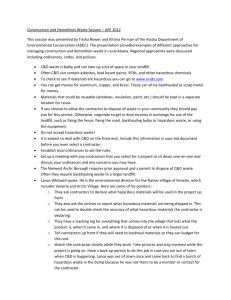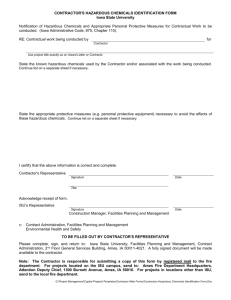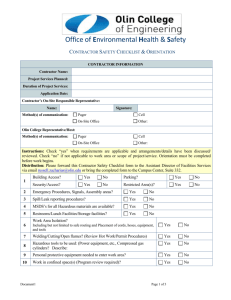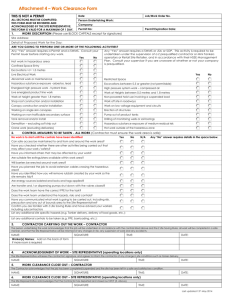Hazardous Waste Controls for Construction, Renovation, and
advertisement
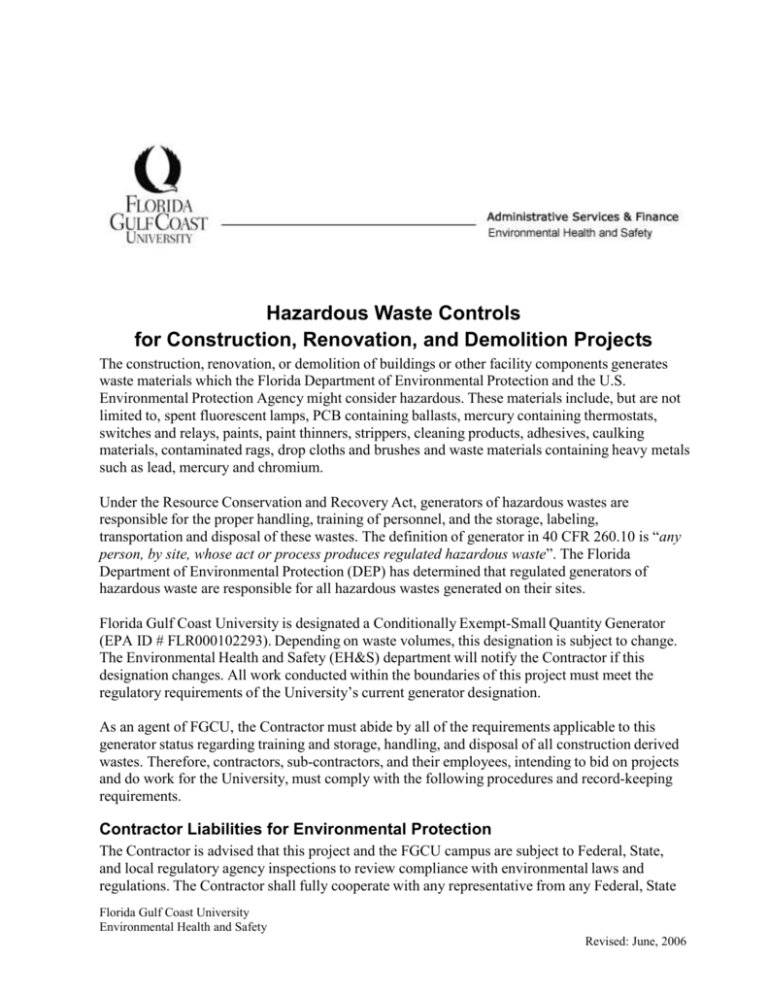
Hazardous Waste Controls for Construction, Renovation, and Demolition Projects The construction, renovation, or demolition of buildings or other facility components generates waste materials which the Florida Department of Environmental Protection and the U.S. Environmental Protection Agency might consider hazardous. These materials include, but are not limited to, spent fluorescent lamps, PCB containing ballasts, mercury containing thermostats, switches and relays, paints, paint thinners, strippers, cleaning products, adhesives, caulking materials, contaminated rags, drop cloths and brushes and waste materials containing heavy metals such as lead, mercury and chromium. Under the Resource Conservation and Recovery Act, generators of hazardous wastes are responsible for the proper handling, training of personnel, and the storage, labeling, transportation and disposal of these wastes. The definition of generator in 40 CFR 260.10 is “any person, by site, whose act or process produces regulated hazardous waste”. The Florida Department of Environmental Protection (DEP) has determined that regulated generators of hazardous waste are responsible for all hazardous wastes generated on their sites. Florida Gulf Coast University is designated a Conditionally Exempt-Small Quantity Generator (EPA ID # FLR000102293). Depending on waste volumes, this designation is subject to change. The Environmental Health and Safety (EH&S) department will notify the Contractor if this designation changes. All work conducted within the boundaries of this project must meet the regulatory requirements of the University’s current generator designation. As an agent of FGCU, the Contractor must abide by all of the requirements applicable to this generator status regarding training and storage, handling, and disposal of all construction derived wastes. Therefore, contractors, sub-contractors, and their employees, intending to bid on projects and do work for the University, must comply with the following procedures and record-keeping requirements. Contractor Liabilities for Environmental Protection The Contractor is advised that this project and the FGCU campus are subject to Federal, State, and local regulatory agency inspections to review compliance with environmental laws and regulations. The Contractor shall fully cooperate with any representative from any Federal, State Florida Gulf Coast University Environmental Health and Safety Revised: June, 2006 or local regulatory agency who may visit the job site, and will provide immediate notification to EH&S. A representative of EH&S will accompany the representative and Contractor on any subsequent site inspections. The Contractor will complete, maintain, and make available to EH&S and other FGCU, or regulatory agency personnel, all documentation relating to environmental compliance under applicable Federal, State and local laws and regulations. The Contractor will immediately notify EH&S if the Contractor is issued a notice of violation, deficiency, or noncompliance for an activity related to health, safety, or the environment. CONTRACTOR agrees to indemnify and hold harmless UNIVERSITY, its governing board, officers, employees, and agents from and against any and all costs, losses, damages, liability, claims, expenses, damages, demands, fees, fines, penalties, suits, proceedings, actions and costs of actions, including court costs and attorney’s fees for trial and on appeal and for the preparation of same, which may arise as a result of CONTRACTOR’s, its officers’, agents’ or employees’ acts in the performance of the services required under this contract. Unforeseen Hazardous or Regulated Material If the Contractor encounters a hazardous material not anticipated in the contract documents which presents a danger to health or the environment, stop that portion of the work and notify EH&S immediately. Examples of potential unforeseen hazardous material include but are not limited to materials containing PCBs, lead paint, mercury, petroleum products, and friable and non-friable asbestos containing materials. Oily and Hazardous Substances The Contractor will prevent oil or hazardous substances from entering the ground, drainage areas, or navigable waters. Surround temporary fuel oil or petroleum storage tanks with a temporary berm or containment of sufficient size and strength to contain the contents of the tanks, plus 10 percent freeboard for precipitation in accordance with 40 CFR 112. The berm will be impervious to oil for 72 hours and constructed so that any discharge will not permeate, drain, infiltrate, or otherwise escape before cleanup occurs. Conduct the fueling and lubricating of equipment and motor vehicles in a manner that protects against spills and evaporation. Manage all used oil generated on site in accordance with 40 CFR 279. Contractor shall determine if any used oil generated while on-site exhibits a characteristic of hazardous waste. In addition, used oil containing 1000 parts per million or more of halogens will be considered a hazardous waste. Used oil mixed with a hazardous waste will also be considered a hazardous waste. Control and Disposal of Solid Wastes Pick up solid wastes, and place in covered containers which are emptied regularly. Prevent contamination of the site or other areas when handling and disposing of wastes. Recycling is encouraged and can be coordinated with EH&S and the FGCU Physical Plant department. Remove all solid waste from University property and dispose off-site at an approved location or facility. Solid waste disposal off-site must comply with the most stringent local, State, or Federal requirements including 40 CFR 241, 40 CFR 243, and 40 CFR 258. Florida Gulf Coast University Environmental Health and Safety Revised: June, 2006 Lighting Fixtures Fluorescent bulbs and ballasts shall be removed from all lighting fixtures prior to disposal. Fluorescent bulbs shall be placed in appropriate size tube cartons from original cartons or available from bulb recycling facilities. Do not break bulbs. Do not tape bulbs. Place broken bulbs in sealed containers and handled separately. Label each box in accordance with FAC 62737 and date. Ballasts shall be separated into PCB and non-PCB categories and placed into separate 55 gallon (or appropriate smaller size) open-head steel drums. Label each drum with appropriate labels: "PCB Ballasts for Recycling" or "Non-PCB Ballasts for Recycling". Paint Remnants Contractor is responsible for removal of excess paint products as well as empty containers from the project. The contractor shall deliver to the Physical Plant department paint shop a sample of each of the paint colors and types used on the project. Each sample is limited to individual metal or plastic 1-gallon paint can in good condition with the appropriate label information attached including the mix specifications and a painted sample on a piece of paper. Rusted or severely dented cans are not in good condition. Dumpsters Equip dumpsters with a cover and keep the cover closed, except when loading trash and debris. Locate dumpsters behind the construction fence and out of the public view to the extent possible. Secure covers on dumpsters not located within the construction fence to prevent unauthorized use. If necessary, provide additional trash containers to collect debris in the construction site area. Locate the trash containers behind the construction fence or out of the public view, and empty at least daily. For large demolitions, large dumpsters without lids are acceptable but should not have debris higher than the sides before emptying. All dumpsters and trash containers must have a “No Hazardous Waste” signs affixed the exterior and visible from all locations where wastes can be put into the container. Adhesive sign model 99 0002 from Screen Graphics of Florida (800-346-4420) or similar is acceptable. Releases/Spills of Oil and Hazardous Substances Take precautions to prevent releases/spills of oil and hazardous materials. In the event of any releases of oil and hazardous materials, chemicals, or gases; immediately (within 15 minutes) notify the University Police Department and EH&S. The University EH&S shall make verbal and written notifications to the appropriate agency as required by Federal or State regulations. The Contractor shall collect and provide information as needed to EH&S. Spill response shall be in accordance with Federal, State and local regulations. Contain and clean up these spills without cost to the University. If University assistance is requested or required, the Contractor shall at the University’s discretion reimburse the University for reasonable expenses arising from such assistance. Florida Gulf Coast University Environmental Health and Safety Revised: June, 2006 Air Conditioning Equipment Remove air conditioning equipment identified for removal without releasing chlorofluorocarbon refrigerants to the atmosphere in accordance with the Clean Air Act Amendment of 1990. Recover all refrigerants prior to removing air conditioning equipment and dispose of as directed by EH&S. Class I ODS as defined and identified herein shall not be used in the performance of this contract, nor be provided as part of the equipment. This prohibition will prevail over any other conflicting provision, specification, drawing, or referenced documents. Florida Gulf Coast University Environmental Health and Safety Revised: June, 2006 REQUIRED SUBMITTALS Environmental Records Binder Maintain on-site, in a separate green three-ring binder(s), copies of all submittals required in this section. Submit this notebook and the included documents to the University’s Department of Environmental Health and Safety at the completion of project. Pollution Prevention The Contractor shall document the management procedures implemented to prevent the accidental release of hazardous or otherwise regulated waste generated on this project. At a minimum, this documentation shall include: 1. Methods of accumulation (i.e., in tanks and/or containers), and designation of the individual(s) responsible for the waste accumulation site(s). 2. Contractor’s management procedures for identification, storage, labeling, transportation, and disposal of hazardous waste and universal waste (treatment of waste is not allowed unless specifically noted). 3. Contractor’s management procedures and regulatory documentation ensuring disposal of hazardous waste complies with Land Disposal Restrictions (40 CFR 268). 4. Contractor’s management procedures for the prevention or control of released hazardous materials. Hazardous Waste Minimization The Contractor shall actively pursue minimizing the use of hazardous materials and the generation of hazardous waste while on the FGCU campus. Contractor shall document the management procedures implemented to minimize the generation of hazardous, universal, and industrial wastes. In addition, the Contractor shall document efforts to identify and recover recyclable materials on this project. At a minimum, this documentation shall include: 1. Contractor’s management procedures for recyclable hazardous materials. 2. Contractor’s management procedures to identify and recover non-hazardous recyclable materials. 3. Contractor’s used oil and oil filter management in accordance with 40 CFR 279. 4. Contractor’s management plan to minimize the generation of hazardous, universal, and industrial wastes. Hazardous Materials List The Contractor shall prepare and submit a list of the hazardous materials, or products containing hazardous materials, intended for use during this project. Called the Hazardous Materials List, this report shall include the project name, estimates of the quantities of the hazardous materials intended for use, copies of the Material Safety Data Sheets (MSDS) for these materials, and the name and contact information for the person(s) preparing this list. Submit this list and revisions Florida Gulf Coast University Environmental Health and Safety Revised: June, 2006 to EH&S for approval prior to bringing any products containing hazardous materials on to the FGCU campus. The use of solvents containing an F-listed (40 CFR 261.31) constituent in excess of 10% by volume is not permitted on the FGCU campus without the prior written permission of the University’s Department of Environmental Health and Safety. To request permission to use a solvent containing an F-listed constituent, document the specific need to use the product, and the procedures that to minimize the amount of product used and to manage wastes and contamination resulting from use of the product. Waste Profile Documentation The Contractor shall complete a waste profile for all wastes resulting from construction, renovation, or demolition activities and/or the use of such products as: all paints caulking materials solvents adhesives aerosols petroleum based material treated lumber cleaning products Contractor may use the form attached at the end of this section “Hazardous Waste Determination Form for Construction, Demolition, or Renovation”, or another form providing equivalent information. Determine waste profiles at the point of generation and sufficiently document whether the waste will be a solid waste, hazardous waste, universal waste, industrial waste, or otherwise regulated waste. Base the waste profile upon a constituent listing from the manufacturer or a visual identification of the waste combined with consideration of the waste generating process, and any laboratory analysis necessary to complete the determination. Material Safety Data Sheets (MSDS) by themselves are not adequate. The Contractor shall bear the cost of the waste profile determinations. Submit the completed waste profile to EH&S for review prior to aggregating or disposing of any solid waste. Laboratory Analysis and Accreditation Certificate/License Retain copies of any laboratory analysis of waste or debris used to support any Waste Profile determination. Analytical laboratories must use EPA approved methods, and be accredited by the National Voluntary Laboratory Accreditation Program, or the American Industrial Hygiene Association, and licensed for work in the State of Florida where applicable. Contractor 40 CFR Employee Training Records The Contractor shall ensure proper classroom or on-the-job training for all persons who work or supervise operations at this project, and whose actions or failure to act may result in noncompliance. This training must teach the participants to perform their duties in a way that ensures compliance with the applicable Federal, State and local hazardous waste regulations appropriate to the University’s current RCRA generator status. Prepare and maintain records of this employee training throughout the term of the project. Florida Gulf Coast University Environmental Health and Safety Revised: June, 2006 Solid Waste Disposal Report Monthly the Contractor shall submit a solid waste disposal report to EH&S. For each waste profile category, this report shall state the classification, amount, location, and name of the business receiving the waste. The Contractor shall include copies of the waste handling facilities’ weight tickets, receipts, bills of sale, copies of all applicable EPA and FL DEP permit(s), manifest(s), or license(s) for transportation, treatment, storage, and disposal of hazardous or otherwise regulated waste, and any other related documentation. In lieu of sales documentation, the Contractor may submit a statement indicating the disposal location for the solid waste, signed by an officer of the Contractor firm authorized to legally obligate or bind the firm. The sales documentation or Contractor certification shall include the receiver’s tax identification number and the business’s EPA or State registration number, along with the receiver’s delivery and business addresses and telephone numbers. For each solid waste retained by the Contractor for his or her own use, the Contractor shall submit on the solid waste disposal report the information previously described in this paragraph. Prices paid or received do not need to be reported to EH&S unless required by other provisions or specifications of this Contract or public law. For all hazardous or otherwise regulated wastes, the Transporter’s Manifest must include the University’s DEP/EPA Identification Number. Address for Submittals The EH&S mailing address is: Environmental Health and Safety FGCU 10501 FGCU Boulevard South Fort Myers, FL 33965-6565 The EH&S office is located in Parking Lot 7 on the FGCU campus and is open from 8:00 am to 5:00 pm on days the University is open. Send electronic submittals ehs@fgcu.edu. The EH&S phone number is (239) 590-1400. Florida Gulf Coast University Environmental Health and Safety Revised: June, 2015 Hazardous Waste Determination Form for Construction, Demolition, or Renovation Project: Waste Description: Generation Process: Estimated Generation Rate: Estimated Total Quantity: Waste Properties, Characteristics, and Constituents Physical State pH □ Solid □ Solid w/free standing or absorbed liquid □ Liquid □ Gas Asbestos Characteristics Content □ Corrosive □ Ignitable □ Reactive □ Radioactive □ None □ Friable □ Non-Friable □ unknown Constituent □ Not Applicable □ Unknown PCB Content □ None □ < 5 ppm □ > 5 ppm □ unknown □ □ □ □ □ ≤2 > 2 but ≤ 5.5 ≥ 5.5 but ≤ 9.0 ≥ 9.0 but ≤ 12.5 ≥ 12.5 Flashpoint □ < 140 ºF □ < 140 but < 200 ºF □ > 200 ºF Metals Content □ Arsenic □ Barium □ Cadmium □ Chromium □ Cobalt Composition Volume % (range) □ Copper □ Lead □ Mercury □ Molybdenum □ Nickel Constituent □ Silver □ Zinc □ Other (note) □ None Volume % (range) Lab Results (if any) Hazard Classification EPA Waste Codes: □ Non-Hazardous (Solid Waste) □ RCRA Waste (Hazardous Waste) □ TSCA Waste (Universal Waste) □Other Regulated Waste Comments: Certification Signing certifies that based on your process knowledge or records on file all information on this form is complete and accurate. Signature Date: Printed initials: Organization Telephone Florida Gulf Coast University Environmental Health and Safety Revised: June, 2015 Florida Gulf Coast University Environmental Health and Safety Revised: June, 2006
